
Already I knew this was going to be a good box. Often I buy large lots of
Japanese pens at antique shops and flea markets without taking the time to look
at each pen. That sounds foolish…I know… but these sellers generally
offer the box as is, either you buy the box or your walk away. And yes, usually
these boxes are nothing but junk. Sometimes there will be a single pen that is
worth what I paid for the whole collection; on the rare occasions I find two or
three good pens.
Not long ago I bought a large collection of Pilot pens that had once belonged
to one of Pilot's vice presidents. The dealer had a fairly good idea what these
pens were worth, and I had to spend a great deal to acquire them. Shortly after
we closed this deal, I started receiving e-mails and phone calls from other dealers,
all with large lots of pens to sell. I guess word travels fast in the antique
circles. None of these collections were as prestigious as the first, but also
they were no where near as expensive. Still, I am not a rich man and buying large
collections of pens every other day starts to add up.
When I received the call from the Yokohama antique dealer, I nearly told him
that I wasn't buying any more pens for awhile, but I am a sucker for the line
"I have a large box of old pens...Want to buy them?"
I told him to send me a jpg of the pens. The image showed over 150 pens, many
of them worn and junk, but a few looked interesting. The image wasn't clear enough
to see any detail, but since the dealer was only asking for $100 for the whole
lot, I said I would take them. As I told him this over the phone, I could hear
the relief in his voice, which scared me to death. It didn't sound like a good
sign for me.
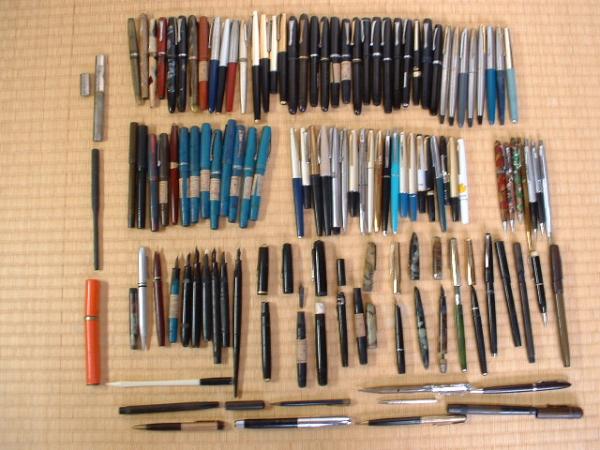
The box of pens from the antique dealer
When the pens arrived, my wife and I opened the box and then went through them
together. Keiko is not a pen collector, but she has the mind of a taxonomist.
She can identify pens just as well as I can now. It is kind of eerie for me to
hear my wife call out "look a 1949 Pilot R-type Lever-filler with the large
imprint"
The first clue that this was going to be a good box was that the first pen
we looked at was indeed the 1949 Pilot, a nice pen, but nothing to turn cartwheels
over. What was important was the fact that the pen still had its gold nib. Nine
times out of ten all of the gold nibs will be missing when I buy collections like
this. Several times throughout history, the price of gold skyrocketed in Japan,
and the value of the gold in the nib alone was worth more than the pen. Unfortunately,
quick-thinking entrepreneurs seized the opportunity, bought all the pens they
could from pen stores and melted down the nibs for a quick little profit.
As we pulled more and more pens out of the box, Keiko was getting excited.
We were stunned to find an early Japanese Swan and a large SSS, and then with
our mouths agape we marveled at a very early Mont Blanc safety with a #7 nib.(perhaps
you saw that one go on ebay recently) But then Keiko pulled out the Holy Grail
Pen. A 1915 Orion.
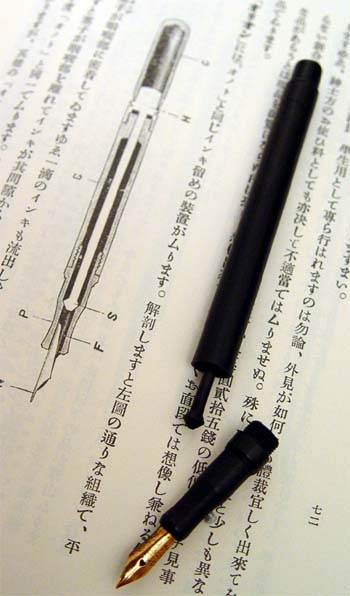
1915 Orion
The Orion isn't worth nearly as much to general collectors as the Montblanc,
but I have been looking for an Orion for a very long time, and I had all but given
up on ever finding one.
Do you remember the spreadsheet program Lotus 123? In the computer industry
it was known as a "Killer App" The program was so successful that millions
of people bought a personal computer for the first time, just to be able to run
this software. The Orion was not the first fountain pen to be sold in Japan, but
it was the first affordable quality pen. Thousands of Japanese writers gave up
their brush pens and switched to fountain pens due to this pen.

Only one store carried the Orion, Maruzen.
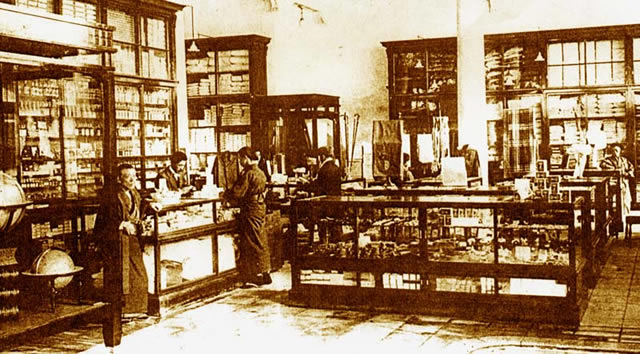
Maruzen in 1915
This import company was founded in 1869 and quickly made a name for itself
by importing rubber Burberry rain overcoats into Japan. Maruzen also imported
a great deal of English books and the store became a haunt for Japan's academic
elite. Maruzen soon forged an important relationship with the English pen maker
Onoto. Maruzen sold pens under the Onoto name, but to make a line of pens more
affordable, Onoto made pen parts with Maruzen's name and shipped the parts.
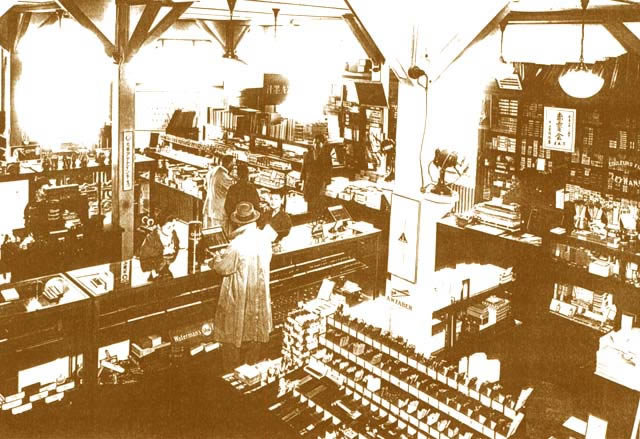
Maruzen in 1919
Workers at the Maruzen store assembled the parts and the Orion was the first
of these. The Orion came in three nib sizes Fine, Medium, and Turned Up. This
last choice was a huge boon to the Japanese. The nib was very similar to a Waterman
#7 with the Yellow nib, which has a ball shaped tip. This allowed for smooth writing
even on the typically rough Japanese Washi paper.
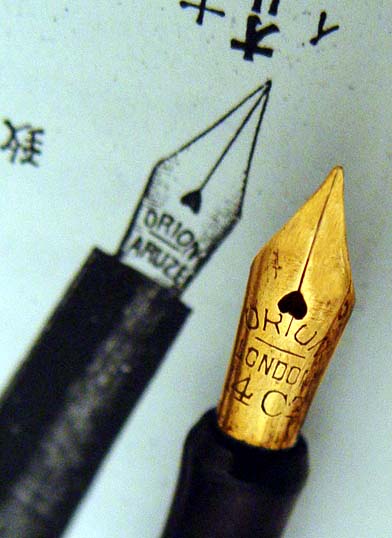
In Maruzen's 1915 catalog the store printed a testimonial letter. I have done
my best to translate it here. It is hard to convey the nuance of the letter, after
all Japan's culture has changed radically since 1915. However, as I read and reread
and looked up the difficult kanji characters in my dictionary, the letter began
to feel familiar. I am sure that if this man were alive today, he would be a regular
contributor for Pentrace.
Dear Sirs:
I would like to thank you for selling the Orion pen. I am not entirely new to
pens, you see, I work for a rather prestigious trading company and my manager
gave me his old faded Waterman pen when he bought a new one to replace it. I enjoyed
that pen, and my sales improved drastically when I switched to a fountain pen.
When signing contracts I didn't need to take the time to mix ink. Most of my competitors
either mix their ink at the customers office, or they carry it ready made in small
ink pots. However the pre-made ink starts to smell bad, and the customers look
down on these salesmen. On the other hand the Fountain pen makes me look modern
and stylish, and this is so important for my business.
However, a month ago, I lost that pen. I looked everywhere for it, but with
no luck. This was a compete tragedy. After using a fountain pen, I couldn't go
back to the brushes, and I certainly couldn't ask my manager for another pen.
At the same time, I couldn't possibly afford to buy a new Waterman pen. I wouldn't
be able to pay my rent. I survived a few weeks by borrowing pens from my coworkers,
but I wasn't making any friends this way.
I went to the pen stores several times and I bought a very cheap pen, but it
was a waste of money. It wouldn't write well and it made a mess all over my desk.
The new Waterman's were lovely, but I didn't even try them out when the clerk
offered. I couldn't possibly afford it and it would only break my heart. Then
I noticed the Orion pen. It looked similar to the more expensive Onotos, but was
priced much more affordably. I asked the clerk to let me try this pen and I was
in love. The nib was smooth and soft, and the pen felt good in my hand. I had
just enough money on me to buy this pen.
After buying the pen I felt a little ill until I returned back to my room and
filled the pen. It wrote as nicely at home as it did in the shop. I used it at
work the next day and it performed flawlessly. I carried it in my Kimono sleeve
and I was impressed with the ink cutoff system. Even after running to catch my
train it didn’t leak at all. I could never have done that with the Waterman
pen.
These days I enjoy writing letters more than ever before, and I have started
keeping a journal. Adding the day’s entry is always a pleasure for me, and
something I look forward to all day.
Thank you once again for selling this pen. I’ll be sure not to lose this
one.
Sincerely, Isitani Ken

Maruzen today - Mrs. Kobayashi behind
the counter
As it so happens Maruzen is still in business. To be sure, it is one of the
best places in Japan to buy English books and magazines, and of course they still
offer pens. They carry most modern makers and have an extensive line of Maki-e
pens to fit any budget. If you have $60,000 burning a hole in your pocket, be
sure to check out some of the Emperor maki-e pens. Check out Russ
Stutler’s Guide to the Japanese pen scene for details. One of the employees
is Mrs. Kobayashi. She speaks a little English; enough to answer detailed questions
about pens, and she is remarkable patient and kind. It makes the two hour trip
from my house always worthwhile.
 Ron
Dutcher has lived in Japan for over 15 years, where he owns and runs a small orthopedic
clinic with his wife, Keiko; which leads him to many Japanese pen finds. His patients,
once they learn of his pen hobby often give him pens as gifts or offer to sell
them to him. He is a member of the Tokyo Pen Association, and has learned a great
deal from Japanese pen collectors. He sells a great many Japanese pens on ebay
under the name Kamakura-Pens, but his true love is for early American pens. He
can be contacted at rd@kamakurapens.com Ron
Dutcher has lived in Japan for over 15 years, where he owns and runs a small orthopedic
clinic with his wife, Keiko; which leads him to many Japanese pen finds. His patients,
once they learn of his pen hobby often give him pens as gifts or offer to sell
them to him. He is a member of the Tokyo Pen Association, and has learned a great
deal from Japanese pen collectors. He sells a great many Japanese pens on ebay
under the name Kamakura-Pens, but his true love is for early American pens. He
can be contacted at rd@kamakurapens.com
|